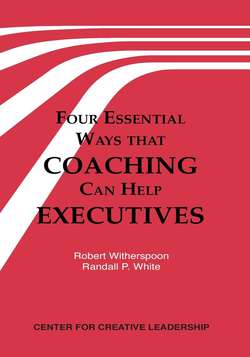Читать книгу Four Essential Ways that Coaching Can Help Executives - Robert Witherspoon - Страница 7
На сайте Литреса книга снята с продажи.
ОглавлениеPreface
This paper represents our thinking about executive coaching: what it is, its power in creating behavioral change, and how it can be used by executives and their organizations.
Each of us comes from a different tradition. The first author began in private practice over twenty-five years ago as a consultant and acquired significant business experience along the way, from building small business start-ups to leadership roles in large organizations. (Before founding Performance & Leadership Development, he was a partner in Arthur Andersen.) The second author started in applied social-science research with a focus on executive learning and leadership and has published widely on these and related topics. (He was formerly in charge of executive coaching and customized programs at the Center for Creative Leadership.)
Along the way, each of us gained experience in designing and delivering executive development programs, and each of us held various managerial positions in the course of our careers prior to offering executive coaching as a service. While we work separately, we sometimes compare notes, and over the course of such comparisons have come to spend long hours discussing the roles that coaches can play and the various situations in which these roles unfold.
We discuss here a continuum of roles and situations with several examples. In writing about individuals with whom we have worked, we have tried to remain true to our commitment to keep data private, while at the same time reporting representative coaching situations. To balance these concerns, some changes in the examples were made for this paper by altering characteristics of each case. The actual work was also abbreviated somewhat. The resulting examples therefore should be considered partial composites of representative coaching situations.
Coaching is about bringing out the best in people. Good coaching, we would argue, begins with clarity about roles. Each coaching situation is different, but some distinctions among roles are important to recognize—if only to foster informed choice by everyone: the executive (and possibly family members), the executive’s boss, the human resources representative, and the coach (or coaches) providing the service. Our purpose here is to probe key distinguishing factors among the coaching situations we encounter daily in our practice.
Beyond informed choice, we hope this paper fosters a dialogue about the roles coaches play. We see a future where coaching is widely available in organizations, where coaching is informed by insights from an evolving practice theory for coaching executives.
A practice theory resembles formal theory but is based on experience, not systematic research. It constitutes a mental map of what’s important and what to do about it. We first learned of “practice theory” from Marvin Weisbord (1987, pp. 260-261), who attributes the concept to Peter Vaill. More recently, Vaill (1989, p. 35) says he meant something very close to the concept of “theory in use” by organizational psychologist Chris Argyris.
We base our practice theory on mental maps drawn up while thinking about a range of coaching cases, such as those presented in this paper. While mental maps paint an incomplete picture of coaching, our aim is to continue clarifying the respective roles of coaching, along with coaching models, best practices, and related matters. We consider this paper to be a work in progress and welcome comments and contributions.
